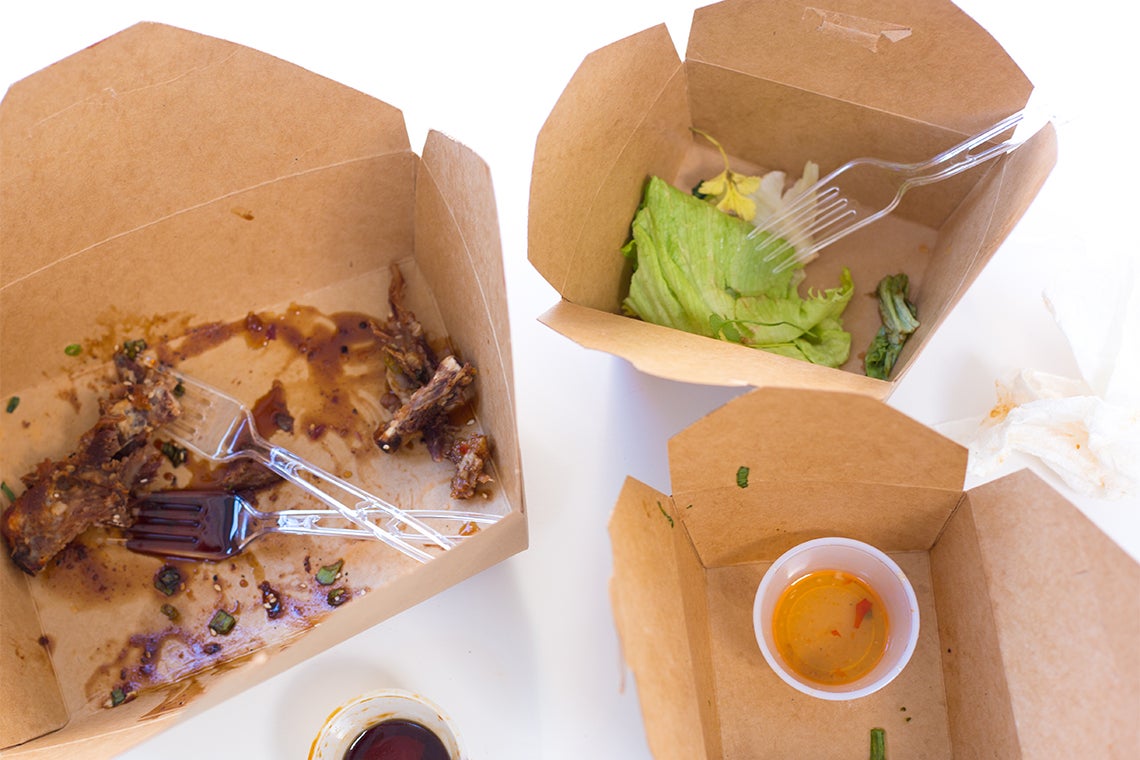New study finds toxic PFAS 'forever chemicals' in Canadian fast-food packaging

Researchers at the University of Toronto, Indiana University and University of Notre Dame have detected levels of toxic PFAS chemicals—short for per- and polyfluoroalkyl substances—for the first time in Canadian fast-food packaging, specifically water-and-grease repellent paper alternatives to plastic.
Published today in Environmental Science & Technology Letters, the findings suggest that food packaging exposes people directly to PFAS, which have been linked to serious health effects such as increased cancer risk and immune system damage, by contaminating the food they eat. Further, once discarded packaging enters waste streams, PFAS enter the environment, where these "forever chemicals" will never break down. These health and environmental risks have prompted 11 U.S. states to ban PFAS from most food packaging, and two major restaurant chains to commit to becoming PFAS-free by 2025.
"As Canada restricts single-use plastics in food-service ware, our research shows that what we like to think of as the better alternatives, such as paper wrappers and compostable bowls, are not so safe and 'green' after all. In fact, they may harm our health and the environment—from our air to our drinking water—by providing a direct route to PFAS exposure," says Miriam Diamond, professor in the Department of Earth Sciences and School of the Environment at the University of Toronto and study co-author.
For the study, the researchers collected 42 paper-based wrappers and bowls from fast-food restaurants in Toronto and tested them for total fluorine, an indicator of PFAS. They then completed a detailed analysis of eight of those samples with high levels of total fluorine. Fiber-based molded bowls, which are marketed as "compostable," had PFAS levels three to 10 times higher than doughnut and pastry bags. PFAS are added to these bowls and bags as a water- and grease-repellent.
PFAS are a complex group of about 9,000 manufactured chemicals, few of which have been studied for their toxicity. A PFAS that is known to be toxic—6:2 FTOH (6:2 fluorotelomer alcohol)—was the most abundant compound detected in these samples. Other PFAS that were commonly found in all the Canadian fast-food packaging tested can transform into this compound, thereby adding to a consumer's exposure to it. They detected several PFAS for the first time in food packaging, showing how difficult it is to track the presence of this large family of compounds.
Critically, the researchers found that the concentration of PFAS declined by up to 85% after storing the products for two years, contradicting claims that polymeric PFAS—a type composed of larger molecules—do not degrade and escape from products. The release of PFAS from food packaging into indoor air presents another opportunity for human exposure to these chemicals.
"The use of PFAS in food packaging is a regrettable substitution of trading one harmful option—single-use plastics—for another. We need to strengthen regulations and push for the use of fiber-based food packaging that doesn't contain PFAS," says Diamond.
More information: Per- and polyfluoroalkyl substances in Canadian fast food packaging, Environmental Science & Technology Letters (2023). DOI: 10.1021/acs.estlett.2c00926
Journal information: Environmental Science & Technology Letters
Provided by University of Toronto New US standards to limit 'forever chemicals' in drinking water
Canadian food packaging found to contain toxic PFAS “forever chemicals” for first time
29 Mar 2023 --- Harmful per- and polyfluoroalkyl substances (PFAS) have been detected in Canadian fast-food packaging – specifically water-and-grease repellent paper alternatives to plastic – for the first time.
The researchers at the University of Toronto (Canada), Indiana University (US) and University of Notre Dame (US) say their findings suggest that food packaging exposes people directly to these so-called “forever chemicals,” which have been linked to serious health effects such as increased cancer risk and immune system damage, by contaminating the food they eat.
Further, once discarded packaging enters waste streams, PFAS enter the environment, where the chemicals will never break down. These health and environmental risks have prompted 11 US states to ban PFAS from most food packaging and two major restaurant chains in Burger King and McDonald’s to commit to becoming PFAS-free by 2025.
“As Canada restricts single-use plastics in foodservice ware, our research shows that what we like to think of as the better alternatives, such as paper wrappers and compostable bowls, are not so safe and ‘green’ after all,” says Miriam Diamond, professor in the Department of Earth Sciences and School of the Environment at the University of Toronto and study co-author.
“In fact, they may harm our health and the environment – from our air to our drinking water – by providing a direct route to PFAS exposure.”
The study’s findings
The researchers collected 42 paper-based wrappers and bowls from fast-food restaurants in Toronto and tested them for total fluorine, an indicator of PFAS.
They then completed a detailed analysis of eight of those samples with high levels of total fluorine. Fiber-based molded bowls, which are marketed as “compostable,” had PFAS levels 3-10 times higher than doughnut and pastry bags.
“Forever chemicals” are added to these bowls and bags as a water- and grease-repellent.
PFAS are a complex group of about 9,000 manufactured chemicals, few of which have been studied for their toxicity. A PFAS that is known to be toxic – 6:2 FTOH (6:2 fluorotelomer alcohol) – was the most abundant compound detected in these samples.
Other PFAS that were commonly found in all the Canadian fast-food packaging tested can transform into this compound, thereby adding to a consumer’s exposure to it. The researchers detected several PFAS for the first time in food packaging, showing how difficult it is to track the presence of this large family of compounds.
The study was published yesterday in Environmental Science and Technology Letters.
A regrettable substitution?
Critically, the researchers found that the concentration of PFAS declined by up to 85% after storing the products for two years, contradicting claims that polymeric PFAS – a type composed of larger molecules – do not degrade and escape from products.
The release of PFAS from food packaging into indoor air presents another opportunity for human exposure to these chemicals.
“The use of PFAS in food packaging is a regrettable substitution of trading one harmful option – single-use plastics – for another. We need to strengthen regulations and push for the use of fiber-based food packaging that doesn’t contain PFAS,” says Diamond.
According to Innova Market Insights, nearly half (37%) of global consumers view food safety as one of their two main concerns when purchasing ready meals like sandwiches and wraps, second only to easy transportation (40%).
Forever in the news
PFAS chemicals are increasingly making the headlines, as the adverse health effects of “forever chemicals” come to light. In January, the US state of New York went as far as to officially ban the use of PFAS in food packaging materials.
This month, the EU began discussions on an upcoming ban on PFAS. ChemSec – the environmental non-governmental organization – created an advocacy campaign called PFAS Movement, which brings together over 100 consumer brands that support a comprehensive ban on the substances.
Researchers at the University of Queensland, Australia, recently developed a novel solution for removing PFAS from water using magnets – something the study authors say is “urgently needed” to combat common public health risks like liver and kidney disease.
Meanwhile, scientists from the Environmental Working Group in Washington, US, revealed that eating one freshwater fish a year is equal to consuming one month of drinking water with PFOS (Perfluorooctanesulfonic acid) – a type of PFAS shown to be harmful.
By Joshua Poole
This feature is provided by FoodIngredientsFirst’s sister website, PackagingInsights.

From makeup to clothing and furniture, so-called “forever chemicals” are everywhere – including the paper bowls and containers used to package Canadian fast-food meals.
In a recent study published in Environmental Science and Technology Letters, Miriam L. Diamond, a professor in the U of T’s department of Earth sciences and School of the Environment in the Faculty of Arts & Science, and her team examined 42 paper-based wrappers and bowls – often billed as an environmentally friendly alternative to single-use plastics – collected from fast-food restaurants in Toronto.
They were looking for potentially toxic human-made perfluoroalkyl and polyfluoroalkyl substances (PFAS), of which there are more than 9,000 in the world.
The most abundant compound detected in the samples was 6:2 FTOH, or 6:2 fluorotelomer alcohol – a PFAS that is known to be toxic. Another finding: fibre-based moulded bowls that are marketed as “compostable” had PFAS levels three to 10 times higher than paper doughnut and pastry bags.

Miriam Diamond
“As Canada restricts single-use plastics in food-service ware, our research shows that what we like to think of as the better alternatives are not so safe and green after all,” Diamond says. “In fact, they may harm our health and the environment by providing a direct route to PFAS exposure – first by contaminating the food we eat, and after they’re thrown away, polluting our air and drinking water.
“The use of PFAS in food packaging is a regrettable substitution of trading one harmful option – single-use plastics – for another.”
The research team included Hui Peng, an assistant professor in the department of chemistry, and, from the department of Earth sciences, recent graduates Anna Shalin and Diwen Yang, as well as research associate Heather Schwartz-Narbonne.
Diamond says PFAS eventually end up in our bodies and the environment, where they stay.
“PFAS are complex, persistent and they don’t break down. Whatever molecule is manufactured today will be in the environment 100 years later,” says Diamond, noting these toxic chemicals are found in a host of everyday products and have been linked to adverse health effects, including an increase in cancer risk, thyroid disease, cholesterol levels and decreased immune response and fertility.
“The bottom line is, there’s too much PFAS in the world and not enough restrictions around their use,” she says. “We need to get serious about replacing these substances with safer alternatives if we want to protect our health, and our planet’s health.”
As an environmental chemist and chemical management expert, Diamond is on a scientific mission to determine the most significant sources of PFAS exposure and spur action to limit their prevalence. As she puts it, there would be no “forever” if these chemicals were never used in the first place.
Diamond saw her research help shape policy last fall when California banned the use of PFAS in fabrics and cosmetics by 2025. This legislation builds on recent studies about PFAS in clothing and makeup that were carried out by Diamond and her colleagues at U of T and institutions around the world.
In a first-of-its-kind paper published in September 2022, the researchers analyzed children’s clothing in Canada and the United States to determine if such apparel is a significant source of PFAS exposure.
They found extremely high levels of these chemicals in school uniforms, mittens and other products marketed as stain resistant. Diamond says because clothing is worn against the skin, there is a higher risk of absorbing and inhaling chemical contaminants – particularly fluorotelomer alcohols, the primary type of PFAS measured in the uniforms.
Diamond notes that PFAS management is becoming a priority in Canada. In 2021, Environment Canada announced it was gathering evidence to address designating PFAS as a class, rather than as individual compounds as part of the federal government’s chemicals management plan. Such designations are important for enabling efficient regulatory practices. The action includes investing in research such as Diamond’s to collect information about sources of the chemicals and levels in the environment through 2023.
“We know where PFAS is used, but we don’t know what the biggest sources of environmental and human contamination are,” Diamond says.
She adds that exposure science has shown high levels of these chemicals in personal care products. So, Diamond and the team investigated PFAS levels in cosmetics in 2021, testing 231 cosmetic products. They found the highest concentration of PFAS in foundations, mascaras and lip products – particularly those that were labelled “wear-resistant,” “long-lasting” or “waterproof.”
“Focusing our attention on cosmetics as a potentially significant route to PFAS was a no-brainer,” she says. “You’re putting them right on your skin, near your eyes, your tear ducts, on your mouth ... is your beauty worth the risk to your health?”
Next, she is turning her attention to building materials such as outdoor durable paints and sealants for concrete and wood, and textiles used in outdoor settings like patio furniture.
“The problem with PFAS is that it is not labelled as an ingredient, so if you want to limit your use of certain products that contain these chemicals, you usually don’t even know what these are,” says Diamond. “That’s when buzzwords will tip you off – like stain-resistant and waterproof. But this vigilance shouldn’t fall only to the consumer.
“In Canada, we need to strengthen chemicals management to improve the health and safety for ourselves and for the next generations. That means better corporate responsibility and government regulations.”



No comments:
Post a Comment